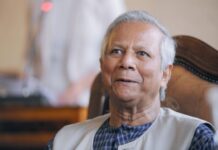
Seven-year-old Saiful Islam had to seek refuge in Bangladesh along with his parents in late 2017, during the military crackdown in Myanmar against the Rohingya community.
While crossing the border, his left leg was suddenly blown up after he stepped on a land mine. Before he knew what happened, he lost consciousness.
After rushing to cross the border, his parents Md Rafique and Ayesha Begum were finally able to admit their son to a hospital.
Saiful, now ten years old, on his first day on Bhashan Char yesterday walked out of the naval ship and took a long breath of joy.
“Now I can walk freely and even play,” he said with a smile on his face, while walking with a crutch and a severed leg.
“Here, the land is plain and open. I can walk about easily,” the 7-year-old said.
Other children like Saiful were also happy after arriving at the char expressed their Joy when they arrived at the island.
1,804 Rohingyas arrived at Bhashan Char yesterday, of whom 848 were children.
They said they were motivated by the first batch, consisting 1,642 Rohingyas, who arrived at the island on December 4. They heard that the housing arrangement is good on Bhashan Char and there is scope of earning a livelihood too.
“My cousins went there with the first batch. They told us about Bhashan Char. And now we are going there,” Abul Kalam, father of two daughters, told The Daily Star yesterday, adding that many of his neighbours in the Cox’s Bazar camps told him to inform them of what it’s like at the char and they will join too.
Mariam Khatun, another Rohingya to arrive at the island yesterday said she would rather call it “Shantir Char (island of peace)”.
“I am going there for peace. I am moving from unrest to peace.
Mariam is among the several lakh Rohingyas who fled to Bangladesh and took refuge in the Rohingya camps in Cox’s Bazar following the brutal military crackdown.
Almost all the Rohingyas confirmed moving to Bhashan Char after seeing pictures and videos of the facilities being built under the Tk 3,100-crore housing project by the Bangladesh Navy.
“The first batch of Rohingyas is basically working as an ambassador of Bhashan char. They are motivating people to come here,” said Commodore AA Mamun Chowdhury, director of the Ashrayan-3 Project (the official name of the Bhashan Char project).
He said that initially it was between 500-700 people, but with time, the number reached 1,772. After some people joined the last minute, 1,804 Rohingyas were relocated yesterday.
Another refugee Shafi Alam said he spoke to those from the first batch who told him the government was arranging work for them and education for their children, along with places to practice religion.
“The Bangladesh government has given us shelter and now it wants to relocate us. The government has arranged everything for us. So why shouldn’t we go there?”

He believes in the coming days more and more Rohingyas will come to Bhashan Char as their security is ensured here.
The department of forest, ministry of agriculture, ministry of education and some other ministries have already visited the island to provide services to the Rohingyas.

The project director said the education ministry will give a report on what sort of education can be offered here.
Ikram Aktar Sweety, 14, said that the Cox’s Bazar camp had become unsafe for girls, especially at night.
“I hope I can go to school here without being disturbed,” she said.
Abu Bakar Siddik, who came here with his wife and four sons, embraced his cousin who came Bhashan Char in the first phase.
“I am feeling good. This is the kind of land [plain] we are used to living on. It was difficult for us in the hilly aea. We were not used to live in hilly area. It’s a relief,” he said.
After arriving at the char, they were taken to a warehouse where they offered a mass prayer expressing gratitude to the almighty.
From there they were taken to their houses.
Meanwhile, the United Nations and other development partners expressed concerns and had demanded independent assessments of the housing project before relocation began. A UN team has still not been allowed to visit the island.
The UN and rights groups have been questioning the relocation plan, saying the island was prone to floods and could be submerged during high tides.









